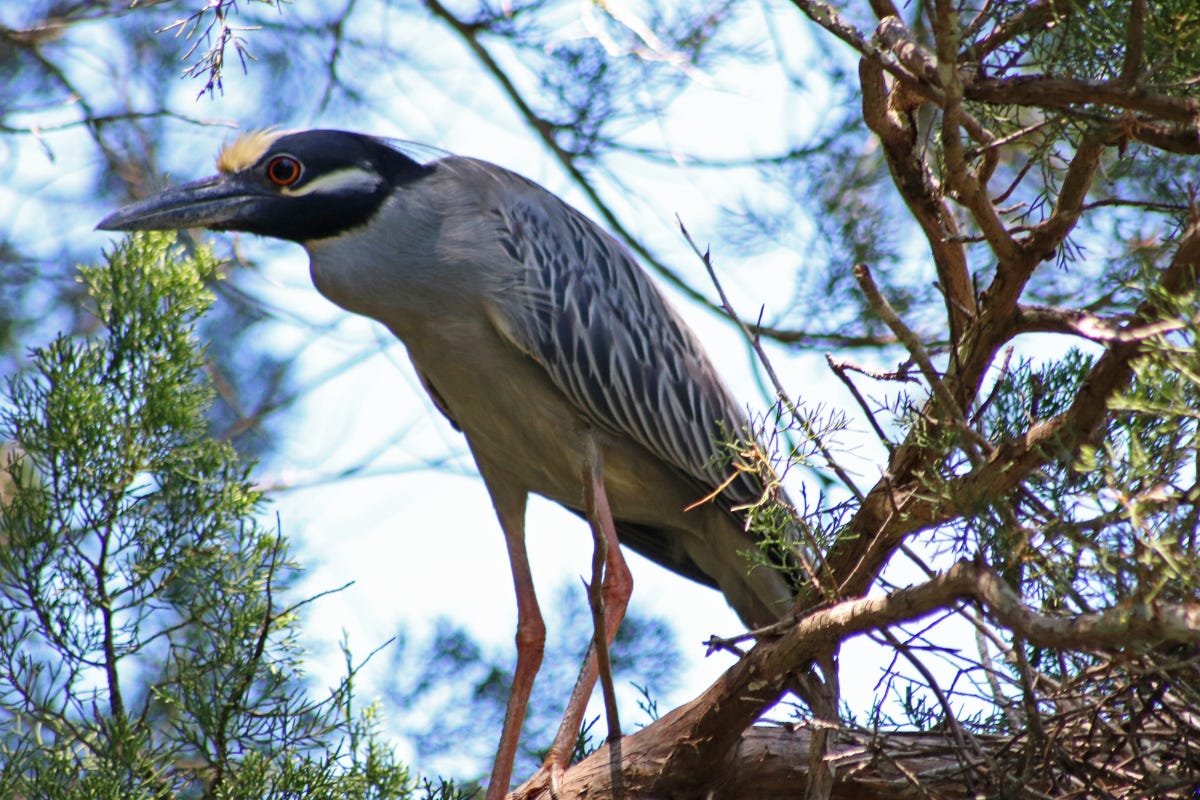On the morning of the total lunar eclipse a few weeks ago, my partner and I went for a long walk in our neighborhood and stopped at a beautiful stretch of canal that is almost completely enveloped under a tree canopy. We weren’t expecting anything, and maybe that’s what made our discovery so delightful.
After sitting on the banks of the canal for a good long time, slowing down, adjusting to the speed of life we were witnessing, we began to see birds quietly perched in the Australian pines whose branches reach across the canal.
This part of South Miami is highly trafficked. It is adjacent to a very busy street and a popular park, with joggers, cyclists, walkers like us, moms and dads with their kids, tennis doubles, pickleball players, guys with fishing poles, high schoolers smoking pot, etc. Amidst all that bustle, it’s really quite astonishing to discover the dramatic worlds of other-than-humans, running quietly parallel to our own.
At first, we spied one yellow-crowned night heron, unmoving on a branch. (It took us awhile, as the ability of these birds to camouflage themselves is extraordinary.) Then after another long-ish while, we spied another, and slowly another, and yet another – several herons, all silent, unmoving, watchful, in the trees, their stillness drawing us into meditation.
On other mornings since then, we have seen herons swooping in and out of one particularly dense section of the trees, where a nest was so expertly hidden it took us five minutes to try to point it out to another curious passerby. This nest had one heron sitting in it, and several, maybe six or seven other herons closeby, standing like sentries. For a good two weeks, the adult herons gradually built two large nests.
A little research informed me that the family of birds herons belong to – Ardeidae – has been on Earth approximately 33 million years, with the modern forms we know today closely resembling ones that first appeared around seven million years ago,1 including the species the yellow crowned night heron belongs to – Nyctanassa violacea.2 Their species survival success is rather remarkable. (Homo sapiens, by comparison, appeared only about 300,000 years ago.)
These creatures are survivors.
Having been fascinated by herons for years, here are a few characteristics I think we humans can learn from them – especially right now.
Collaboration.
Herons are rather solitary birds, but they come together at breeding time, often banding together in colonies (or small groups in the case of the yellow crowned night heron). Collectively, they raise their young. Watching them together build a strong, protective, educational environment for the next generation over these past few weeks has been an incredible lesson in collaboration.
Stealth & Observation.
These birds can be incredibly stealthy when they want to be. They do not call attention to themselves while guarding their nests. They stand quietly, almost undetectable, observing their surroundings. They search out the right environments where food is plentiful, and band together to do the work of the species.
Patience.
Watching a heron hunt aquatic life is a lesson in patience. They don’t expend a lot of energy in their hunting. They observe, wait, and strike with precision in a kind of open-eyed meditation.
The Moon becomes full on Saturday, April 12, at 8:22pm Eastern Time.
Set against a backdrop of stars the ancient Seers of India called “Chitra,” this time is helping us see, and give gratitude for the design of things as they are, and to identify what about those designs we wish to reform.
With a hearty dose of Saturn in the mix, we would be wise to play a long game. Our designs need to take into account what we want future generations to experience, and what resources we want to leave them – what material resources, what knowledge, what vision for a future.
Given the configurations at this full moon, (Venus, Saturn, Rahu, Mercury conjunct; Venus exchanging signs with Jupiter), our designs will benefit from Heron wisdom – prioritize relationships and learn to build, nurture, protect collaboratively; build quietly, deliberately, without excess, striving to match the environment; and patiently procure the resources we and our Beloveds need.
I feel very fortunate to be witnessing this little family of yellow crowned night herons during breeding season. They feel to me like guides from the natural world.
May the full moon on the canal be bright for the herons. And may the full moon wherever you are be bright for you.
Watts, B. D. (2020). Yellow-crowned Night Heron (Nyctanassa violacea), version 1.0. In Birds of the World (A. F. Poole, Editor). Cornell Lab of Ornithology, Ithaca, NY, USA. https://doi.org/10.2173/bow.ycnher.01





What a beautiful argument for ending human supremacy and for appreciating all species and forms of life!
Amazing, thank you, Marga. May this full moon continue to bring deep appreciation ❤️🌈